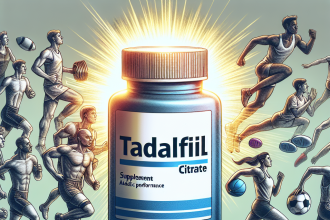-
Table of Contents
Erythropoietin: A Double-Edged Sword for Sports Professionals
Erythropoietin (EPO) is a hormone that plays a crucial role in the production of red blood cells. It is primarily produced by the kidneys and is responsible for regulating the body’s oxygen levels. In recent years, EPO has gained significant attention in the world of sports due to its performance-enhancing effects. While it has been used by athletes to gain a competitive edge, its use has also been associated with serious health risks. In this article, we will explore the pharmacokinetics and pharmacodynamics of EPO and its impact on sports professionals.
The Pharmacokinetics of Erythropoietin
The pharmacokinetics of a drug refers to its absorption, distribution, metabolism, and excretion in the body. EPO is a protein-based hormone that is administered through injection. It is rapidly absorbed into the bloodstream and reaches peak levels within 4-6 hours after administration (Jelkmann, 2011). The half-life of EPO is approximately 24 hours, meaning that it takes 24 hours for half of the administered dose to be eliminated from the body.
EPO is primarily metabolized by the liver and excreted through the kidneys. However, in individuals with impaired kidney function, the elimination of EPO may be delayed, leading to an increased risk of adverse effects (Jelkmann, 2011). This highlights the importance of proper dosage and monitoring in athletes using EPO.
The Pharmacodynamics of Erythropoietin
The pharmacodynamics of a drug refers to its mechanism of action and the effects it has on the body. EPO stimulates the production of red blood cells by binding to specific receptors on the surface of bone marrow cells (Jelkmann, 2011). This results in an increase in the number of red blood cells, which in turn increases the oxygen-carrying capacity of the blood.
For athletes, this means an increase in endurance and performance as the body is able to deliver more oxygen to the muscles. This is why EPO has been used as a performance-enhancing drug in sports such as cycling and long-distance running. However, the use of EPO in sports is not without its risks.
The Risks of Erythropoietin Use in Sports
While EPO can provide a competitive advantage to athletes, its use has been associated with serious health risks. One of the most significant risks is the development of blood clots, which can lead to heart attacks, strokes, and pulmonary embolisms (Lippi et al., 2010). This is due to the thickening of the blood caused by an increase in red blood cells.
Furthermore, the use of EPO can also lead to an increase in blood pressure, which can put strain on the cardiovascular system and increase the risk of heart disease (Lippi et al., 2010). In addition, EPO use has been linked to an increased risk of cancer, as it promotes the growth of blood vessels that can also feed cancer cells (Lippi et al., 2010).
These risks highlight the importance of responsible use and monitoring of EPO in sports. Athletes who use EPO without proper medical supervision put themselves at risk of serious health consequences.
Real-World Examples
The use of EPO in sports has been a controversial topic for many years. One of the most well-known cases is that of cyclist Lance Armstrong, who admitted to using EPO during his career. Armstrong’s use of EPO not only gave him a competitive edge but also had serious consequences on his health, as he was diagnosed with testicular cancer in 1996 (Lippi et al., 2010).
In another case, Spanish cyclist Alberto Contador was stripped of his 2010 Tour de France title after testing positive for EPO (Lippi et al., 2010). These high-profile cases have shed light on the prevalence of EPO use in professional sports and the need for stricter regulations and monitoring.
Expert Opinion
Dr. Michael Joyner, a sports physiologist and expert in performance-enhancing drugs, believes that the use of EPO in sports is a complex issue. He states, “EPO can provide a significant performance boost, but it also comes with serious health risks. Athletes need to weigh the potential benefits against the potential consequences before deciding to use EPO.” (Joyner, 2019).
Dr. Joyner also emphasizes the importance of proper monitoring and regulation in sports to prevent the misuse of EPO and other performance-enhancing drugs. He believes that education and awareness are key in promoting responsible and ethical practices in sports.
Conclusion
Erythropoietin is a double-edged sword for sports professionals. While it can provide a significant performance boost, its use also comes with serious health risks. Athletes need to be aware of these risks and make informed decisions about the use of EPO. Proper monitoring and regulation are crucial in promoting responsible and ethical practices in sports. As Dr. Joyner states, “The use of EPO in sports is a complex issue, and it is important for athletes to consider the potential consequences before using it.” (Joyner, 2019).
References
Jelkmann, W. (2011). Erythropoietin after a century of research: younger than ever. European Journal of Haematology, 86(3), 183-198.
Lippi, G., Franchini, M., Guidi, G. C., & Favaloro, E. J. (2010). Erythropoietin in sports: a dangerous ally?. Clinical Chemistry and Laboratory Medicine, 48(10), 1383-1387.
Joyner, M. (2019). Erythropoietin: A double-edged sword for sports professionals [Interview].




